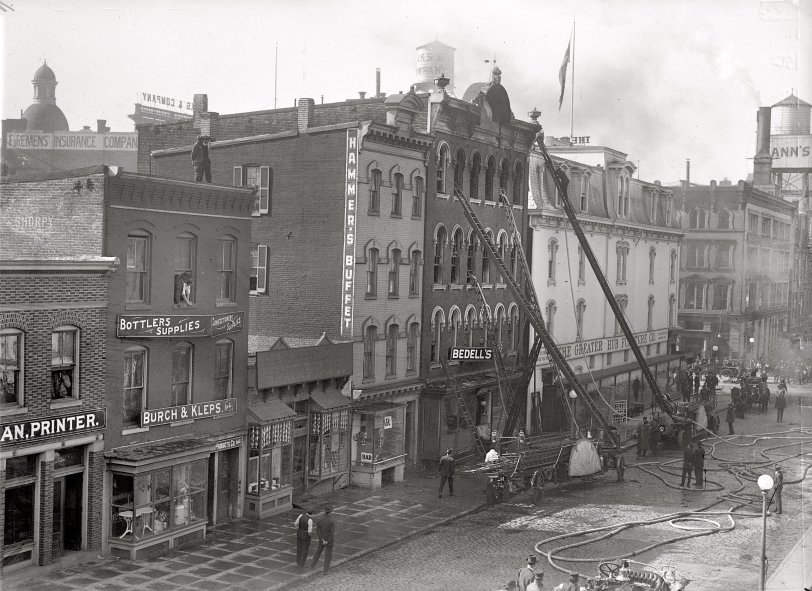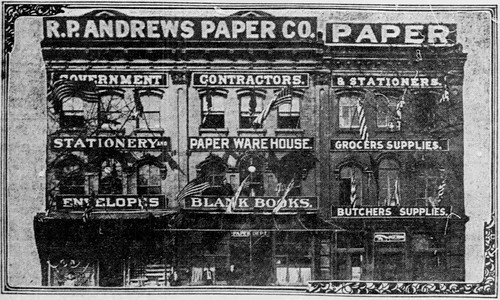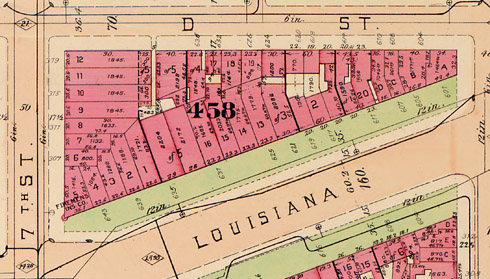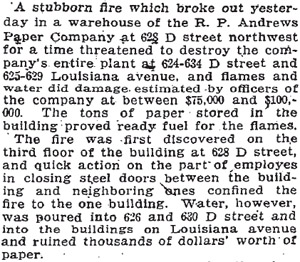


Framed or unframed, desk size to sofa size, printed by us in Arizona and Alabama since 2007. Explore now.
Shorpy is funded by you. Patreon contributors get an ad-free experience.
Learn more.

- Lofty addition
- In 1912
- Keenan Building
- Six years old
- Taken from the P.J. McArdle Roadway?
- It stood only 47 years
- Three track mind
- Incline to the right
- Reach for the sky, 1912 style
- No clean sweep
- Same Job Title, Same Face
- Sadly Lost
- Beautiful ...
- Where you get your kicks
- Aim High
- Pueblo Revival sisters
- Pueblo Neoclassicism
- Milk Man
- Regional dialect.
- Spielberg's inspiration
- Great Photo
- Loaf Story
- Do you still have the Rakes category?
- Could almost be a scene from the 1957 movie 'Hell Drivers'
- The Wages of Fear.
- Conspicuous by their absence
- Got Milk?
- All that aluminum
- No lefties
- Smoke 'em if you've got 'em
Print Emporium
The Smoking Bed: 1915

October 23, 1915. Washington, D.C. "Bedell fire, Seventh & D streets." Bedell Manufacturing made mattresses. Three years after a fire in 1912, R.P. Andrews Paper has vacated its D Street premises, but the block still seems unusually combustible. National Photo Company Collection glass negative. View full size.
Don't jump!
@:
Jump!
Submitted by Anonymous Tipster on Sat, 02/21/2009 -1:44pm.
No the "folded trampolines or catchers for people jumping out of buildings" are not used anymore in the US fire service that I know of. I did 34 years and never even drilled with them. They are called Life Nets. Believe they were taken off the aerial trucks in the late 1960's.
Jump!
Are those semicircular things on the sides of the ladder trucks folded trampolines or catchers for people jumping out of buildings? Are they still used?
Hauling hoses
Hoses were (and still are) hauled up with no water in them.
Back in these days they most likely used cotton jacketed 2.5in hose with a rubber liner inside.
Weight wise for 2.5in diameter line you are looking at around 160 lbs per 50ft section (110lbs of water + roughly 50 lbs for hose and couplings).
DCFD Apparatus
The equipment in this photo appears to be:
Truck Co. 10 -- 1907 Seagrave 65-foot aerial ladder, horse drawn (rear view).
Truck Co. 3 -- 1907 American LaFrance 75-foot aerial ladder with 1914 Christie Tractor attached.
Combination chemical hose wagon with three horses.
McDermott Bros. fuel wagon (between the streetlights) dropping off coal for a steam fire engine.
Behind the coal wagon, to the far right, a steam fire engine.
In the foreground, Engine Co. 16 Ahrens Fox 700 gpm pumper.
A series of tubes
Wow. How did these guys haul those hoses up into the building? Was it just by hand? I mean, look at the section of hose hanging down from the tallest ladder. That would have to weigh an incredible amount.
D.C.F.D.
I'm a member of the DC Fire Department now assigned to the Drill School. Shorpy is a part of our morning routine while we have our 0530 Staff Meeting before the day begins. The old DCFD pictures that you have posted are used to show the Rookies and us "OLD GUYS " how things have not really changed that much.
Thanks
Cosgrove
[Thanks back! Shorpy has always wanted to ride on a firetruck! - Dave]
Up There
So many interesting things in this pic but the thing that sticks out the most for me is the tall ladder with the guy looking down. I guess I never would have made a fireman in 1915.
As a printer by trade
As a printer by trade and have been in the business in Washington for 30 years, I'm wondering what is the full name of the print shop shown in the lower left hand corner of the photo?
[A name ending in "-ffman." - Dave]
R.P. Andrews had moved ...
... to rather grander quarters in the 600 block of Louisiana Avenue, NW:

They opened there in 1909, and seem to have consolidated operations after being burned out on D.
[The D Street and Louisiana Avenue addresses of Andrews Paper were one group of buildings the same block; they backed up to each other. The buildings on both streets were damaged by the fire. See below. - Dave]


Howdy Neighbor
Wonder if Firemen's Insurance Company had anything to do with this.
























On Shorpy:
Today’s Top 5